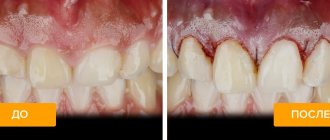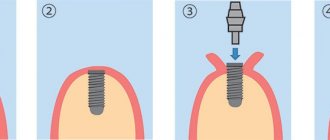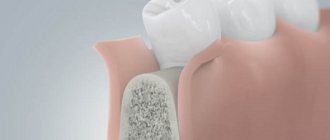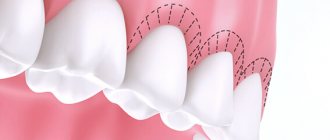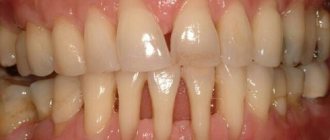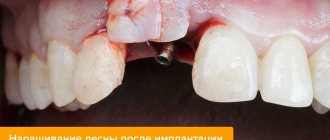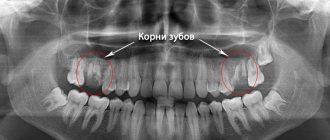- Indications
- Contraindications
- Stages of treatment
- Rehabilitation
- Advantages and disadvantages
- Laser gingivoplasty
- Upon implantation
- Advantages of the ROOTT Clinic
- Prices
- Doctors
- Reviews
A beautiful smile gives confidence and gives aesthetic pleasure. For such a smile, it is not enough to have beautiful teeth; your gums also need to match. But with age, due to physiological, traumatic and other reasons, our gums recede. The edges become thinner, the soft tissues are not enough to cover the roots of the teeth and they become exposed. This process is called a recession.
Or, conversely, there is too much tissue, it creeps onto the teeth, making them visually small.
The most productive way to eliminate the problem is gum surgery - an operation to restore or change the gingival contour. Sometimes this intervention is called gingivoplasty. These are simply two names for the same procedure.
- When to use:
too large periodontium, recession, mucosal defects - Procedure time:
up to 1 hour - Treatment period:
from 1 day - After the procedure:
compliance with medical recommendations - Type of anesthesia:
local
As a result of the operation, the gums acquire a smooth, clear contour, which significantly rejuvenates the smile. But it’s not just the cosmetic effect that makes doctors perform gum surgery.
Indications for gingivoplasty
Such operations are not classified as complex surgical interventions. They do not last long and are performed under local anesthesia.
Recommended for:
- Gum recession
A bare root is not only an unaesthetic appearance, it is tooth hypersensitivity. Teeth react to cold and hot, sour and sweet. The absence of an obstacle in the form of a tissue barrier opens the way for bacteria and can provoke periodontal inflammation. Gum grafting when the root is exposed is the most popular operation in clinics.
- Sloughing of gum tissue
, presence of
large gum pockets
This happens with periodontal diseases. Food and decay products get clogged under the edge of the gum. Bacteria gain access to the tooth root, cementum and pulp.
- Contour correction
before installation of the prosthesis
To make the artificial tooth less noticeable, correction is carried out both on the lower and upper gums.
- Soft tissue hypertrophy
The gums cover most of the teeth, making them small, “shark-like.” In these cases, excess tissue is removed.
- Correcting a “gummy smile”
Sometimes a smile shows gums rather than teeth. Most often the upper gum is exposed. Surgery is also performed to restore balance and allow the teeth to shine rather than the gums.
- Periodontal diseases
, which result in gum atrophy - Upon implantation
Advantages of our center for modern dentistry:
Why you should contact Uniklinik Center for Modern Medicine LLC in Moscow:
- Our clinic employs doctors of medical sciences, professors, and dentists who regularly take advanced training courses in Russia and European countries.
- For 15 years we have been providing dental services of very high quality.
- The clinic has a computed tomograph, a cephalostat, a digital modeling system, and a dental microscope.
- We use modern treatment methods - invasive bone surgery, immediate implantation, tooth extraction, periodontal surgery, all types of prosthetics and orthodontic treatment.
Thanks to such a thorough and comprehensive approach to each patient, and coordinated work in a team of highly qualified doctors, for many years we have been obtaining very highly aesthetic and functional work, which our patients enjoy with great joy.
Contraindications
When considering surgery, it is necessary to take into account not only the indications, but also the contraindications. They also exist for patchwork gum surgery in dentistry. It is worth noting that this list tends to shrink and more and more diseases are becoming relative or disappearing from contraindications altogether.
Relative
the procedure can be carried out with extreme caution
- Chronic diseases in the acute stage;
- inflammatory processes in the oral cavity;
- caries;
- tartar and dental plaque.
Absolute
the procedure is strictly prohibited
- Blood diseases that affect blood clotting;
- immunodeficiency;
- uncompensated diabetes mellitus;
- myocardial infarction in the last 6 months;
- chemotherapy.
Prevention
In order to significantly reduce the risk of developing this disease, experts advise their patients to follow these rules:
- It is necessary to carry out timely treatment of caries, since it is the main cause of the development of recession.
- Visit your dentist regularly for preventative checkups. The earlier this pathology is diagnosed, the less time and effort will be spent on eliminating it.
- Avoid injury and bleeding gums. To do this, it is necessary to correct malocclusions using the most gentle methods possible, periodically strengthening tooth enamel through remineralizing therapy.
- It is necessary to pay significant attention to high-quality oral hygiene. Brush your teeth properly and do not use a brush with too hard bristles.
Gum recession is a serious disease that requires prompt intervention from a specialist. Therefore, it is necessary to periodically undergo a preventive examination at the dentist and practice proper oral hygiene.
Operation stages
1. Preparatory
A preliminary examination of the oral cavity is carried out, the scope of intervention is determined, and a treatment plan is drawn up.
If necessary, teeth cleaning or curettage is prescribed - cleaning the gum pockets. This is necessary to remove foci of infection in the oral cavity.
2. Anesthesia
In most cases, the operation is performed under local anesthesia. In case of phobia and severe nervous excitement, sedation is given.
3. The actual operation
Excess tissue is simply removed with a scalpel. Gum augmentation is carried out using tissue from the soft palate. It sounds like a serious transplant, but in fact the operation is not complicated and lasts 20-25 minutes.
4. Suturing and wound disinfection
The surgeon sews a piece of tissue to the desired location and disinfects the surgical field.
Classification of recessions
Regarding the severity, this disease can have three forms:
- Light.
- Average.
- Heavy.
And if in the first case the gums recede by a maximum of 3 mm, then in severe cases the receding can be more than 5 mm.
Recession can be either local or generalized, when it covers the entire oral cavity. And regarding the method of flow, it can be both visible and hidden. The latter option can only be diagnosed through probing.
Regarding the nature of the disease, recession occurs:
- Traumatic, which develops in patients under thirty years of age. It is most often observed on the front surface of the teeth. In this case, the root is exposed by 1-2 mm, and the sensitivity of the soft tissues increases noticeably. Aesthetic defects also appear, but inflammation is extremely rare.
- Symptomatic, which can develop at any age on the vestibular or lingual surface of the teeth. In patients under 35 years of age, this process can occur in the interdental gingival spaces.
The cause of this disease is poor oral hygiene. As a result, dental plaque appears, as well as diseases such as periodontitis and gingivitis. With this type of recession, swelling, bleeding, suppuration and loosening of the teeth may occur. The cause of the disease is most often trauma resulting from caries treatment.
- Physiological. Which is most often observed in elderly patients as a result of aging periodontal tissue. Their exposure is noticeable to the naked eye. Soft tissues almost never become inflamed, and teeth remain stable.
Rehabilitation
The duration of the recovery period depends on the individual characteristics of the body, the volume and complexity of the intervention.
Recommendations:
- Do not drink for 2 hours, then drink water at room temperature
- Don't eat for at least 5 hours
- Apply ice to relieve swelling
- Wear a mouthguard to fix tissues for 10 days
- Brush your teeth carefully, without touching the seams
- After eating, rinse your mouth with water or solutions recommended by your doctor.
- Eliminate hot, sour, spicy foods. Avoid food that is too cold or too hot
- In the first days after surgery, reduce physical activity
The swelling subsides gradually during the first week. If the swelling does not subside, the body temperature rises, the operation site continues to be painful, and bloody discharge appears in the mouth, you should immediately consult a doctor.
Methods
Most often during implantation:
- eliminate gum recession;
- build up the alveolar ridge;
- restore gingival papillae.
The alveolar ridge is the process of the jaw that forms the tooth socket. In the absence of a tooth, the bone tissue decreases, the process becomes flat. There may not be enough space to strengthen the implant.
Alveolar ridge plastic surgery is performed with bone material of artificial or natural origin. A block of bone tissue is placed on the alveolar process, covering the gum tissue on top. This is done before installing the implant.
After the implant has healed, a gum former is installed on it. However, this is not always enough for the appearance of gingival papillae - the tissue that fills the space between the teeth. Then plastic papillae are performed after installation of implants. The procedure is performed using the same flap technique as other operations. The autograft is transplanted onto the gum so that it fills the space between the teeth.
The same technique is used for gum recession.
Laser gingivoplasty
Surgeries using laser technology are becoming increasingly popular. Unfortunately, the high cost of equipment makes laser surgery available only in certain dental centers.
Features of laser gingivoplasty:
- Pain is weak or absent
- Thin and precise incision preserves tissue
- No stitches reduces the risk of complications
- The surgical field is completely sterile
- No postoperative swelling
Recovery occurs quickly, and the traumatism of the operation tends to zero.
Unfortunately, the price of gum surgery using a laser is higher than that of conventional surgery. Another drawback is that the laser is only available in large clinics and such an operation is impossible in a small district dentistry.
Attention!
Progressive recession of the gum tissue can lead to tooth loss , as a result of which it will be necessary to replace it with prosthetics, which will cost much more than the cost of gum surgery.
If you need help with issues related to the condition of your gums, contact our dental clinic.
Date of publication: September 20, 2020 Last update: September 22, 2021 © 2020 Professorial Dentistry “22 Century”. All rights reserved.
Gum plastic surgery during implantation
When installing implants, the main emphasis is on the preservation of bone tissue. But in our body everything is interconnected and the loss of soft tissue also affects the successful implantation. Therefore, one of the indications for gum augmentation is implantation. The operation is performed using the patient's own tissue or an artificial membrane.
The operation solves several problems at once:
- Restore the required volume
- Prevents deformation of soft tissues
- Protect underlying tissues from aggressive influences
- Contributes to implant stability
- Create an even contour
The operation is carried out according to the same scheme as plastic surgery for gum recession.
Read more: About gum plastic surgery during implantation
Article Expert
Kopylova Lyubov Ivanovna Dentist-therapist, doctor of the highest category
Work experience: more than 11 years
How much does surgical treatment cost?
The cost of surgery to restore gums starts from 15,000 rubles. For creating an ideal contour around one tooth.
In case of significant bone deficiency, additional bone grafting may be performed. The decision to use this treatment method is made by the doctor based on the results of computer diagnostics.
The specialists of Dr. Lemberg Dental Clinic are waiting for you for a consultation, where you can see all the equipment used, get answers to all your questions and undergo a comprehensive diagnosis to draw up a comprehensive treatment plan. Doctors will make every effort to make your smile perfect.
Specialists
Beldy Nikolay Olegovich
Chief physician, orthopedic dentist
Work experience: more than 19 years
Shishkin Yuri Andreevich
Dental surgeon, implantologist
Work experience: more than 6 years
Patient reviews
- Zharikova
Surgeon Yu. A. Shishkin is simply super! He found an approach to me, and I’m a terrible crybaby! He calmed me down, felt sorry for me, explained everything, everything went painlessly. Shishkin, you are super!!! - Elizabeth
I would like to say a big thank you to Yuri Andreevich Shishkin! Super specialist! Always polite and in a good mood. He'll tell you everything and calm you down if you're scared. He talks about where to be patient and where it will be unpleasant. Overall a very nice person! He is now removing all my wisdom teeth. It doesn't hurt at all! If problems arise, he gives you his phone number and you can immediately ask for help. I will recommend him to everyone!
ALL REVIEWS
Reasons to contact ICDI ROOTT
- The clinic uses unique methods of implantation, bone and gingivoplasty.
- The center is a member of the European organization of dentists Open Dental Community, which means it has access to new developments and methods
- The clinic's doctors have extensive experience working with bone and soft tissue plastic surgery.
- The clinic performs operations on patients who were refused elsewhere due to contraindications.
- ROOT is a multidisciplinary clinic - all services are provided in one place.
- The clinic uses an attractive financial policy, which makes the cost of services ultimately lower than the Moscow average.
- The clinic pays special attention to the safety of treatment through multi-level sterilization.
What complications may arise?
Sometimes after gingivoplasty the following may appear:
- severe sensitivity of surrounding tissues;
- the appearance of edema;
- painful sensations.
The listed side effects are easily eliminated or go away on their own as they heal.
Another negative consequence of the operation may be an allergic reaction to the anesthetic. If you are prone to allergies, it is better to notify your doctor in advance and get tested.
